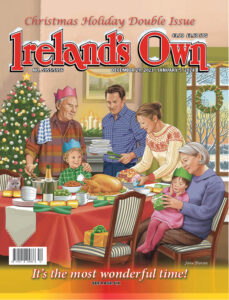EUGENE DALY looks at some folklore associated with the Advent season.
Now, in Advent, with nature supressed and people at a low ebb, some brightness is needed and Christmas obliges.
The summer solstice on June 21st and the winter solstice on December 21st were of huge significance to the people who built the ancient monuments such as Newgrange, where at dawn at the winter solstice light flows through the hole above the capstone, reflecting on the carved stone and the bones of the dead piled at the end of the main passage.
 The midwinter return of the sun reassured the community that light was returning, that growth would start again and life would continue.
The midwinter return of the sun reassured the community that light was returning, that growth would start again and life would continue.
If the origins of a midwinter feast seem to be closer to the Roman feast of Saturnalia, or with trappings of the Yule log and the Christmas tree to Scandinavia and Germany, rather than to Celtic tradition, it is clear that a long time before the Celts arrived in Ireland, about 350 B.C., the people marked the winter solstice by celebrating the rebirth of the sun.
In more recent times, Christmas has become the archetypal family feast and its customs bring light and comfort. The candle in the window, the presents left in stockings hung on the bedrail or by the fire, the dark green of ivy and the bright red of berried holly used to decorate the house: all of them help us through the dark time.
In the past Christmas was a time when the community came together at fairs such as the ‘big market’ which was held before Christmas. This was where dried fruit and other luxuries such as the goose or spiced beef were purchased, to be consumed with pleasure after the Advent fast. The market was also a chance to meet those people who lived at a distance and were rarely seen.
Continue reading in this week’s Ireland’s Own


